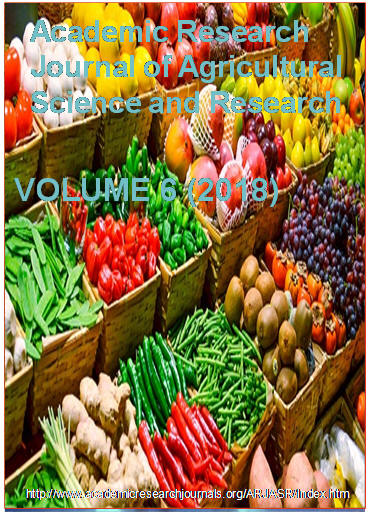| ARJASR |
Academic Research Journal of
Agricultural Science and Research |
|||||||||||||||||||
|
Vol. 6(9), pp. 577-583. December, 2018. ISSN: 2360-7874 DOI: 10.14662/ARJASRD2018.097 Full Length Research Evaluation of chemical composition of improved and released soybean varieties in Ethiopia
Samuel Mesfin*
*Agricultural Quality Research Laboratories, Ethiopian Institute of Agricultural Research (EIAR), P.O. Box 2003, Addis Ababa, Ethiopia. Correspondence should be addressed to samimesfin98@gmail.com
Accepted 16 November 2018
Soybean (Glycin Max) is one of the most important oil crops worldwide. Due to its high protein composition, it becomes the best choice to tackle protein malnutrition in developing countries, particularly for low income communities. This study was aimed to evaluate the chemical compositions of soybean varieties released in Ethiopia to generate baseline information for breeders, growers and nutritionists so that they will be able to choose the appropriate variety for their own purpose based on their chemical compositions. Seventeen (17) soybean varieties were used for this study and their proximate composition, amino acid and fatty acid compositions were determined according to the standard procedures. The protein and oil content of these varieties was found to be in the ranges of between 30.71% - 37.68% and 16.97%-22.86% respectively. Jalele was found to be significantly higher in protein content followed by Clarck63k and, in crud fat (oil content), Davice was found to be significantly higher among all varieties followed by AGS-7-1 and Belesa-95. All varieties were found to contain all of the essential amino acids Williams being the highest (14.15%) compared to other varieties. All varieties generally showed high level of unsaturated fatty acids with PUFA/SFA ratio between in the ranges of 2.89 (Nova) – 3.76 (Wegayen) which, in general, meets the requirement set by WHO/FAO to be greater than 0.4. The ω-6/ ω-3 ratio for all varieties ranges between 6.33 (Gishama) – 7.78 (Belesa-95) which may be a limiting factor for soybean nutrition and, thus, have to be combined with other food, rich in ω-3 fatty acids. Hence it can be concluded that the use of improved varieties with higher level of protein or unsaturated fatty acids can enhance the nutritional value of soy based food products.
Key words: Soybean, Nutrition, Varieties
How to cite this article (APA Style): Mesfin, S (2018). Evaluation of chemical composition of improved and released soybean varieties in Ethiopia. Acad. Res. J. Agri. Sci. Res. 6(9): 577-583
|
|||||||||||||||||||
